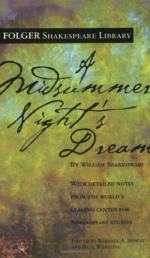|
This section contains 6,140 words (approx. 21 pages at 300 words per page) |

|
SOURCE: “Varieties of Love, Variations of Genre,” in A Midsummer Night's Dream, Northcote House Publishers Ltd, 1997, pp. 32-46.
In the following essay, Hackett explores the way A Midsummer Night's Dream vascillates between tragic and comic possibilities.
Comedy is above all the drama of love; the conventional marker of a comic happy ending is at least one marriage, founded on the mutual desire of the two partners. In A Midsummer Night's Dream, we get marriage three times over—four if we count the reunion of Oberon and Titania—emphatically confirming that what we have witnessed is a comedy. It is a play where ‘Jack shall have Jill, / Naught shall go ill’ (III. ii. 461-2), forming an outright contrast to another comedy by Shakespeare, Love's Labour's Lost (1594-5), composed not long before A Midsummer Night's Dream, in which the nuptials of another four couples are deferred and ‘Our wooing doth...
|
This section contains 6,140 words (approx. 21 pages at 300 words per page) |

|


